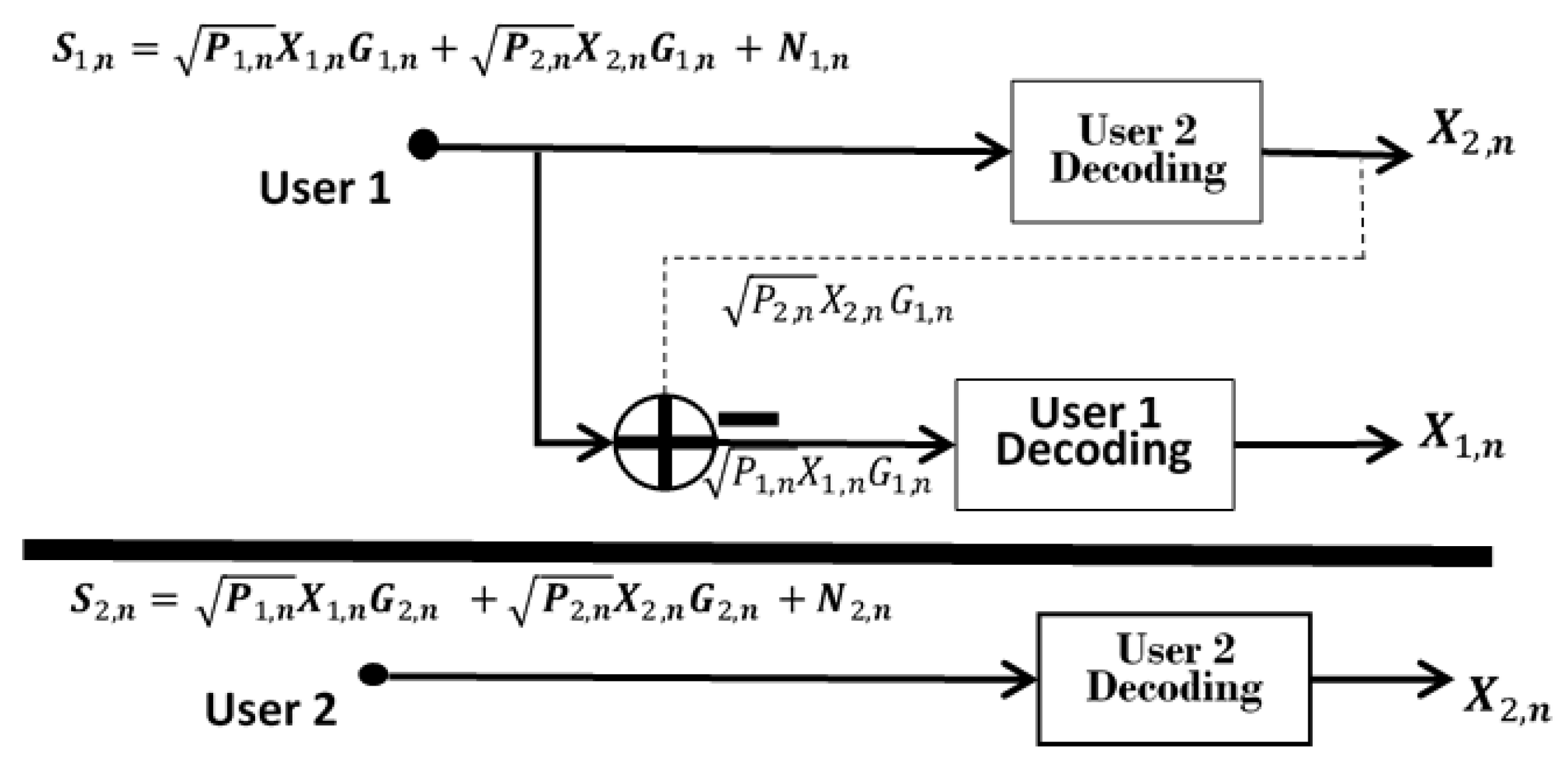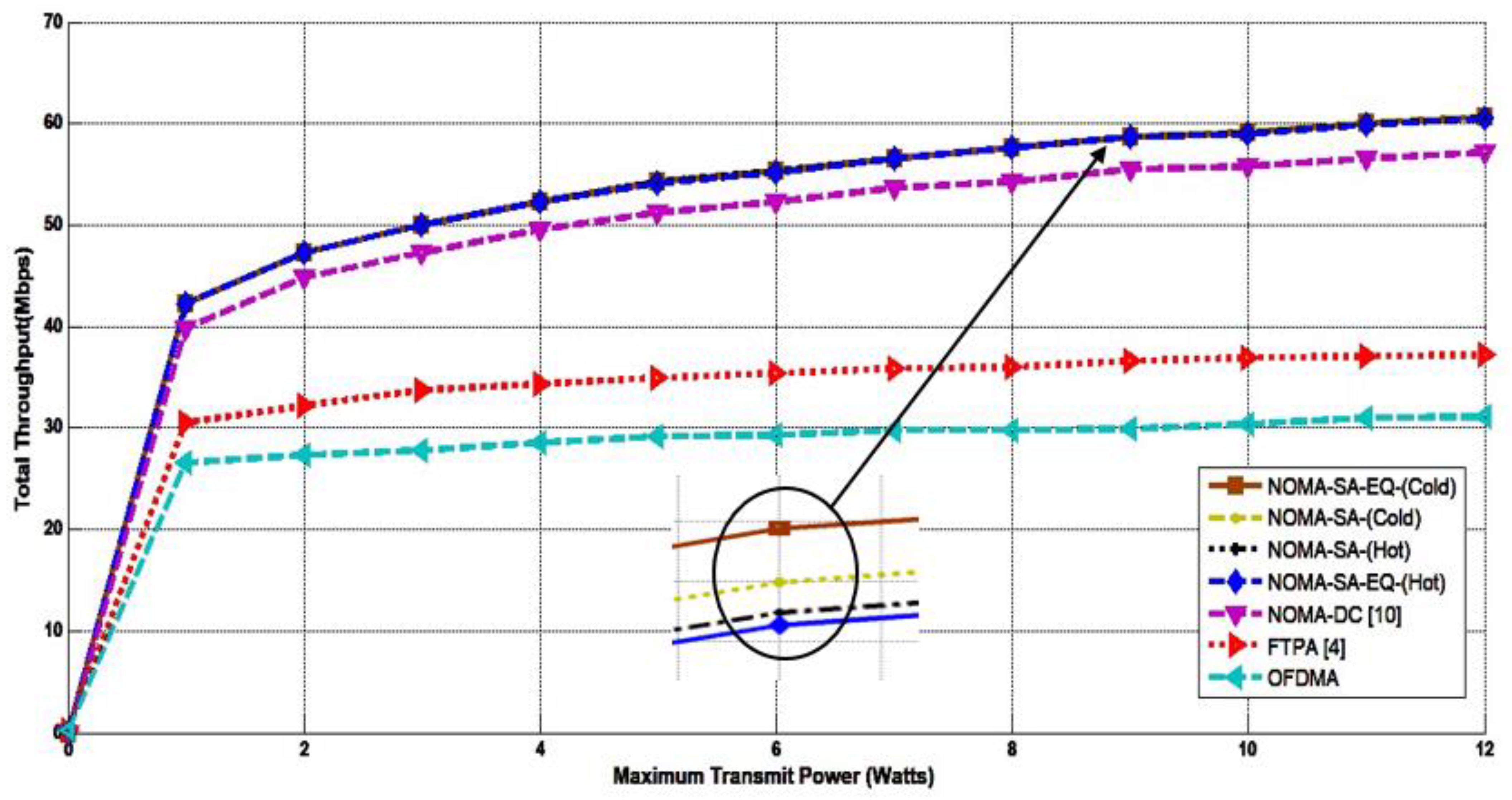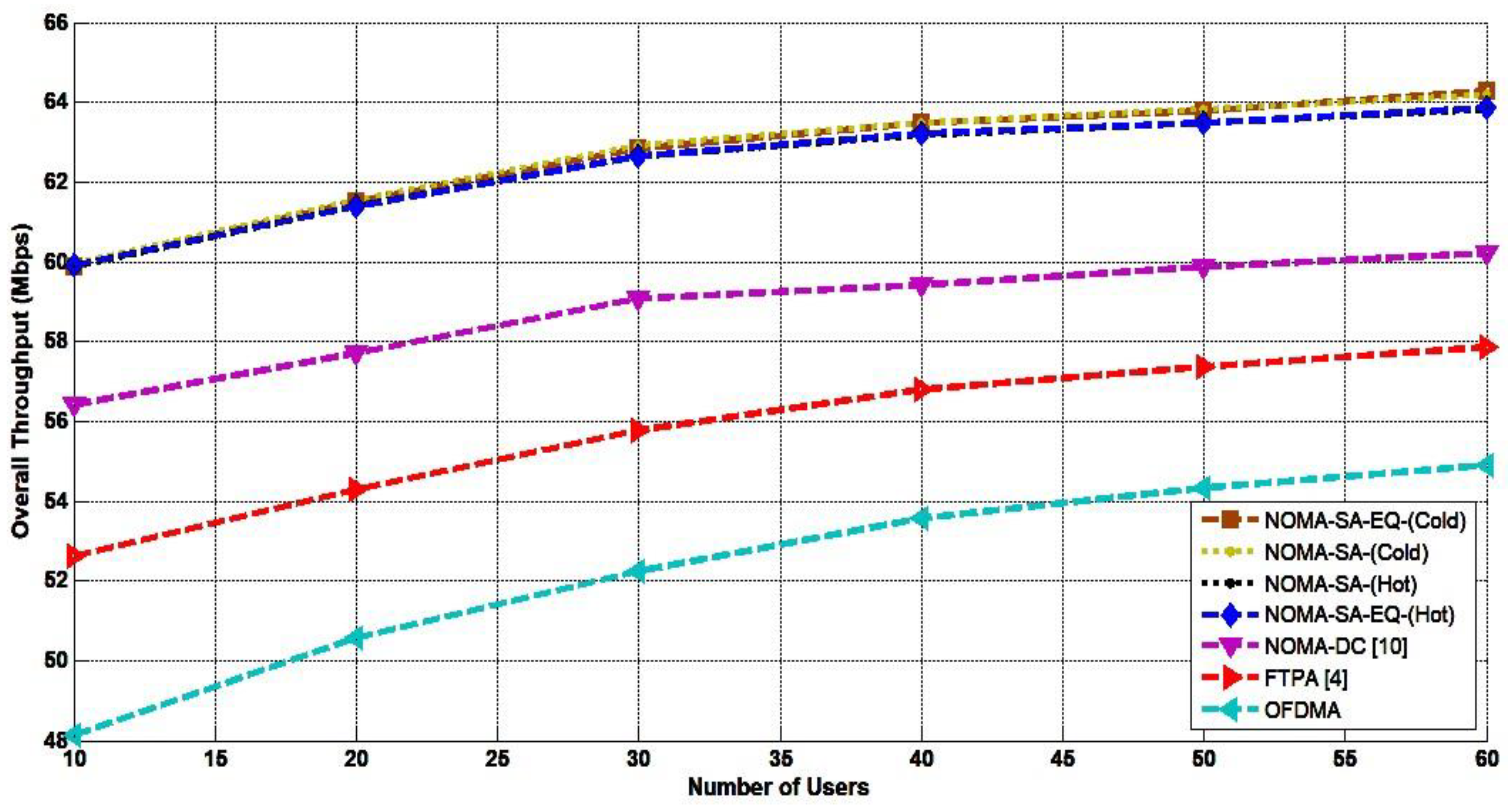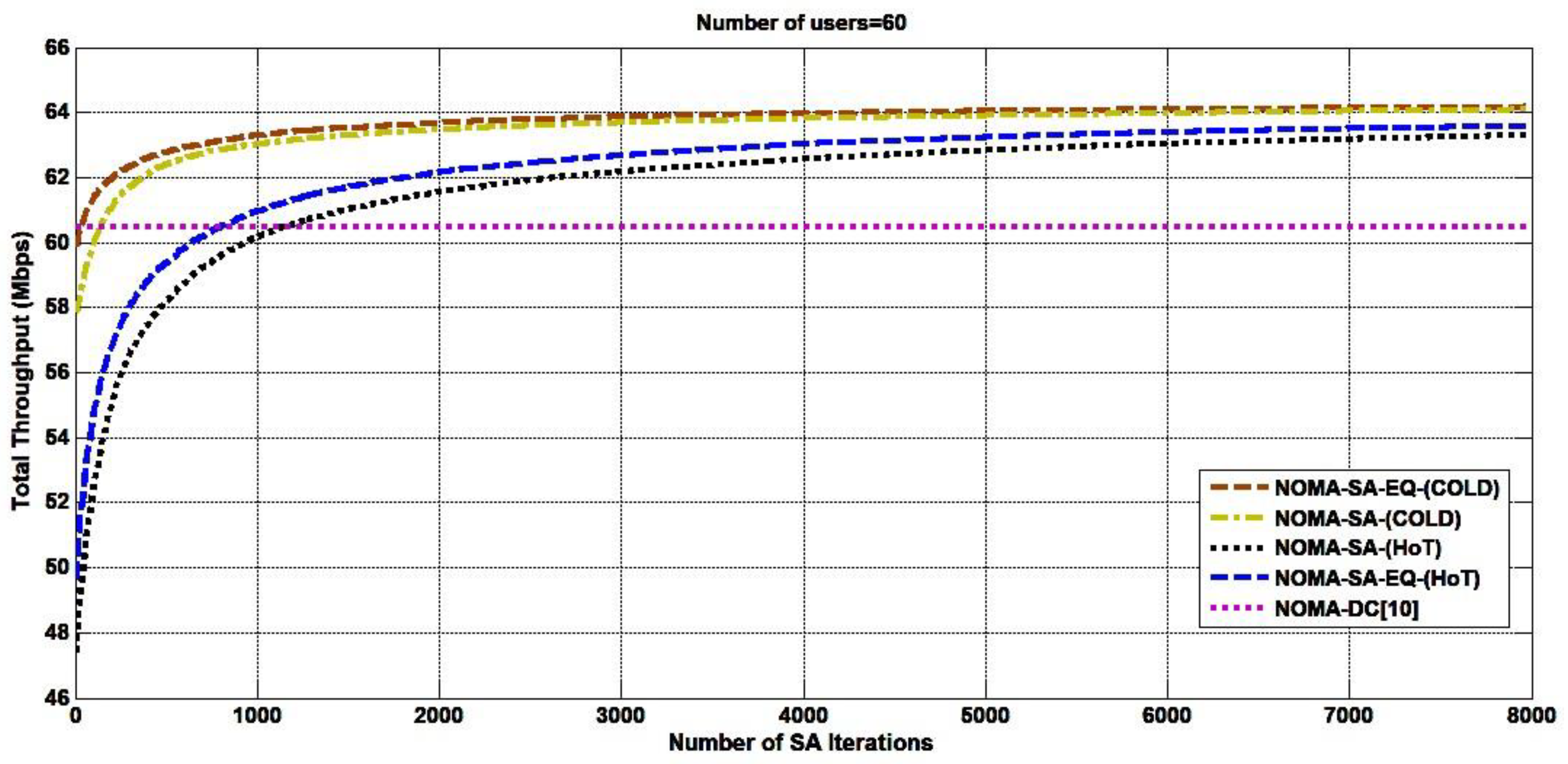Simulated Annealing for Resource Allocation in Downlink NOMA Systems in 5G Networks
Abstract
:1. Introduction
1.1. Preliminaries
1.2. Related Work
2. NOMA System Model
Problem Formulation
3. Simulated Annealing Based Resource Allocation
3.1. SA for User Pairing
| Algorithm 1: Proposed SA Subchannel and User Matching Scheme. |
|
3.2. SA for Subchannel Power Allocation
3.3. SA for Proportional Power Allocation
| Algorithm 2: Proposed SA-based Subchannel Power Scheme. |
|
| Algorithm 3: Proposed SA-based proportional Power Scheme. |
|
4. Result and Performance Analysis
5. Conclusions
Author Contributions
Funding
Institutional Review Board Statement
Informed Consent Statement
Conflicts of Interest
Appendix A
Appendix B
References
- Dai, L.; Wang, B.; Yuan, Y.; Han, S.; Chih-Lin, I.; Wang, Z. Non-orthogonal multiple access for 5G: Solutions, challenges, opportunities, and future research trends. IEEE Commun. Mag. 2015, 53, 74–81. [Google Scholar] [CrossRef]
- Al-Falahy, N.; Alani, O.Y. Technologies for 5G networks: Challenges and opportunities. IT Prof. 2017, 19, 12–20. [Google Scholar] [CrossRef] [Green Version]
- Wu, Q.; Li, G.Y.; Chen, W.; Ng, D.W.K.; Schober, R. An overview of sustainable green 5G networks. IEEE Wirel. Commun. 2017, 24, 72–80. [Google Scholar] [CrossRef] [Green Version]
- Razavi, R.; Dianati, M.; Imran, M.A. Non-orthogonal multiple access (NOMA) for future radio access. 5G Mob. Commun. 2016, 135–163. [Google Scholar] [CrossRef]
- Wang, C.L.; Chen, J.Y.; Chen, Y.J. Power allocation for a downlink non-orthogonal multiple access system. IEEE Wirel. Commun. Lett. 2016, 5, 532–535. [Google Scholar] [CrossRef]
- Zamani, M.R.; Eslami, M.; Khorramizadeh, M. Optimal sum-rate maximization in a NOMA system with channel estimation error. In Proceedings of the 26th Iranian Conference Electrical Engineering (ICEE), Mashhad, Iran, 8–10 May 2018; pp. 720–724. [Google Scholar] [CrossRef]
- Sun, Q.; Han, S.; Chin-Lin, I.; Pan, Z. On the ergodic capacity of MIMO NOMA systems. IEEE Wirel. Commun. Lett. 2015, 4, 405–408. [Google Scholar] [CrossRef]
- Shi, H.C.; Lanjie, L.B. Pairing and power allocation for downlink nonorthogonal multiple access systems. IEEE Trans. Veh. Technol. 2017, 66, 10084–10091. [Google Scholar] [CrossRef]
- Parida, P.; Das, S.S. Power Allocation in OFDM Based NOMA Systems: A DC Programming Approach. In Proceedings of the 2014 IEEE Globecom Work, GC Workshops, Austin, TX, USA, 8–12 December 2014; pp. 1026–1031. [Google Scholar] [CrossRef]
- Fang, F.; Zhang, H.; Cheng, J.; Leung, V.C.M. Energy-efficient resource allocation for downlink non-orthogonal multiple access network. IEEE Trans. Commun. 2016, 64, 3722–3732. [Google Scholar] [CrossRef]
- Wang, Q.; Zhao, F. Joint spectrum and power allocation for noma enhanced relaying networks. IEEE Access 2019, 7, 27008–27016. [Google Scholar] [CrossRef]
- Al-Abbasi, Z.Q.; So, D.K.C. Power Allocation for Sum Rate Maximisation in Non-Orthogonal Multiple Access System. In Proceedings of the PIMRC IEEE International Symposium on Personal Indoor Mobile Radio Communications, London, UK, 7–10 September 2015; Volume 2015, pp. 1649–1653. [Google Scholar] [CrossRef]
- Choi, J. Power allocation for max-sum rate and max-min rate proportional fairness in NOMA. IEEE Commun. Lett. 2016, 20, 2055–2058. [Google Scholar] [CrossRef]
- Wang, X.; Chen, R.; Xu, Y.; Meng, Q. Low-complexity power allocation in NOMA systems with imperfect SIC for maximizing weighted sum-rate. IEEE Access 2019, 7, 94238–94253. [Google Scholar] [CrossRef]
- Ahmed, T.; Yasmin, R.; Homyara, H.; Hasan, M.A.F.R. Generalized power allocation (GPA) Scheme for non-orthogonal multiple access (NOMA) Based wireless communication system. Int. J. Comput. Sci. Eng. Inf. Technol. 2018, 8, 1–9. [Google Scholar] [CrossRef]
- Ding, Z.; Fan, P.; Poor, H.V. Impact of user pairing on 5G non-orthogonal multiple-access downlink transmissions. IEEE Trans. Veh. Technol. 2016, 65, 6010–6023. [Google Scholar] [CrossRef]
- Bao, W.; Chen, H.; Li, Y.; Vucetic, B. Joint rate control and power allocation for non-orthogonal multiple access systems. IEEE J. Sel. Areas Commun. 2017, 35, 2798–2811. [Google Scholar] [CrossRef] [Green Version]
- Zhu, J.; Wang, J.; Huang, Y.; He, S.; You, X.; Yang, L. On optimal power allocation for downlink non-orthogonal multiple access systems. IEEE J. Sel. Areas Commun. 2017, 35, 2744–2757. [Google Scholar] [CrossRef] [Green Version]
- Al-Abbasi, Z.Q.; So, D.K.C. Resource allocation in non-orthogonal and hybrid multiple access system with proportional rate constraint. IEEE Trans. Wirel. Commun. 2017, 16, 6309–6320. [Google Scholar] [CrossRef] [Green Version]
- Fu, Y.; Salaun, L.; Sung, C.W.; Chen, C.S. Subcarrier and power allocation for the downlink of multicarrier NOMA systems. IEEE Trans. Veh. Technol. 2018, 67, 11833–11847. [Google Scholar] [CrossRef]
- Abuajwa, O.; Tan, C.K.; Ng, Y.H.; Lee, C.K. ACO-based power allocation for throughput maximization in the downlink 5G NOMA systems. Int. J. Eng. Res. Technol. 2020, 13, 3072–3079. [Google Scholar] [CrossRef]
- Gallo, C.; Capozzi, V. A simulated annealing algorithm for scheduling problems. J. Appl. Math. Phys. 2019, 7, 2579–2594. [Google Scholar] [CrossRef] [Green Version]
- Benjebbour, A.; Li, A.; Kishiyama, Y.; Jiang, H.; Nakamura, T. System-Level Performance of Downlink NOMA Combined with SU-MIMO for Future LTE Enhancements. In Proceedings of the 2014 IEEE Globecom Work, GC Workshops, Austin, TX, USA, 8–12 December 2014; pp. 706–710. [Google Scholar] [CrossRef]
- Benjebbour, A.; Saito, K.; Li, A.; Kishiyama, Y.; Nakamura, T. Non-orthogonal multiple access (NOMA): Concept, Performance Evaluation and Experimental Trials. In Proceedings of the International Conference on Wireless Networks Mobile Communication (WINCOM), Marrakech, Morocco, 20–23 October 2015; pp. 1–6. [Google Scholar] [CrossRef]





| Reference | Objective | Proposed Algorithm |
|---|---|---|
| [5] | To maximize the sum rate for SISO and MIMO NOMA system. | Closed-form solution for power allocation with KKT condition. |
| [6] | Maximize the sum rate for the NOMA system with imperfect channel state information (CSI). | Optimal power using KKT condition. |
| [7] | Maximization of the ergodic capacity. | Bisection search-based power allocation. |
| [8] | Maximize the weighted sum rate of a downlink NOMA system. | Minimum mean square error (MMSE). |
| [9] | Maximize the total sum rate for orthogonal frequency-division multiple-access (OFDM) based NOMA. | User, channel matching, and iterative power allocation scheme based on the difference of convex (DC) programming. |
| [10] | Improve Throughput and energy efficiency for the NOMA system. | Subchannel matching for user and subchannel assignment and DC. |
| [11] | Maximize the Throughput for the NOMA-enhanced relay network. | Simulated annealing (SA) for subcarrier and user assignment and DC for power allocation |
| [12] | Maximize the NOMA’s system total sum rate. | Two closed-form suboptimal solutions using the Lagrange multiplier. |
| [13] | Maximize the sum rate with minimum rate constraint for downlink NOMA with two users. | The proportional fairness scheduling (PFS). |
| [14] | Maximize the weighted sum rate (WSR). | Iterative fractional quadratic transformation algorithm. |
| [15] | Maximize the sum rate and investigate the BER performance in the NOMA system. | Generalized power allocation (GPA). |
| [16] | Maximize the sum rate by evaluating the impact of user pairing. | Channel gain difference with fixed power allocation. |
| [17] | Maximize the Throughput in the NOMA system. | Lyapunov optimization framework. |
| [18] | Improve the Throughput for the NOMA system. | Two-sided matching scheme combining the power allocation and maximum fairness (MMF). |
| [19] | Sum-rate maximization under constraints of total power and proportional rate. | Hierarchical pairing power allocation (HPPA). |
| [20] | Maximize the sum rate for MC-NOMA. | Projected gradient descent algorithm and greedy heuristic search. |
| [21] | Maximize the sum rate for NOMA. | Ant colony optimization (ACO) and LTE bandwidth division. |
| Parameters | Values |
|---|---|
| Bandwidth BW | 5 MHz |
| Subcarrier BW | 2 kHz |
| Cell Radius | 500 m |
| Min distance between UE-BS | 50 m |
| Min distance between UE-UE | 40 m |
| Number of Subchannels () | 128 |
| Maximum Transmit Power () | 12 Watt |
| Maximum multiplexed users on the same subchannel | 2 users |
| Total Number of users | 60 users |
| Noise Power Spectral Density (No) | −174 dBm/Hz |
| User Minimum Data Rate | 500 b/s |
| Number of Transmit Antenna | 1 |
| Noise Figure | 9 dBm |
| Shadow Standard Deviation | 8 dB |
| Throughput calculation | Shannon’s capacity |
Publisher’s Note: MDPI stays neutral with regard to jurisdictional claims in published maps and institutional affiliations. |
© 2021 by the authors. Licensee MDPI, Basel, Switzerland. This article is an open access article distributed under the terms and conditions of the Creative Commons Attribution (CC BY) license (https://creativecommons.org/licenses/by/4.0/).
Share and Cite
Abuajwa, O.; Roslee, M.B.; Yusoff, Z.B. Simulated Annealing for Resource Allocation in Downlink NOMA Systems in 5G Networks. Appl. Sci. 2021, 11, 4592. https://doi.org/10.3390/app11104592
Abuajwa O, Roslee MB, Yusoff ZB. Simulated Annealing for Resource Allocation in Downlink NOMA Systems in 5G Networks. Applied Sciences. 2021; 11(10):4592. https://doi.org/10.3390/app11104592
Chicago/Turabian StyleAbuajwa, Osama, Mardeni Bin Roslee, and Zubaida Binti Yusoff. 2021. "Simulated Annealing for Resource Allocation in Downlink NOMA Systems in 5G Networks" Applied Sciences 11, no. 10: 4592. https://doi.org/10.3390/app11104592
APA StyleAbuajwa, O., Roslee, M. B., & Yusoff, Z. B. (2021). Simulated Annealing for Resource Allocation in Downlink NOMA Systems in 5G Networks. Applied Sciences, 11(10), 4592. https://doi.org/10.3390/app11104592






